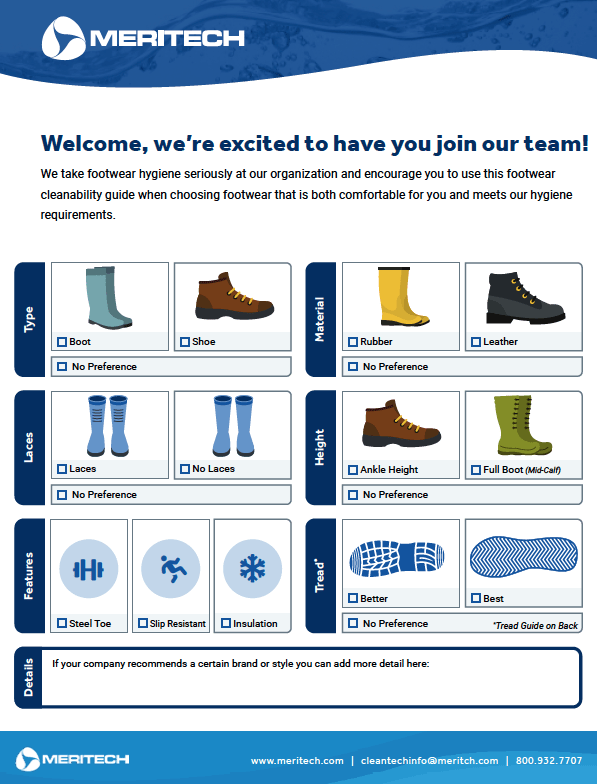Captive Footwear Programs 101
What is a Captive Footwear Program?
A captive footwear program is truly the precipice of great footwear hygiene practices at any organization. “Captive” or “Zoned” footwear is a subcategory of plant shoes where the footwear is designated to a certain zone in the plant, such as an allergen or ready-to-eat production zone. Essentially with this program, the footwear stays in one particular area of the plant, ensuring zero cross-contamination between high and low risk production areas and provides the ultimate safety for your consumers.

Learn more about footwear hygiene methods in our footwear hygiene ebook!
Considerations for a Captive Footwear Program
While a captive footwear program may be one of the best methods for footwear hygiene There are several key aspects to consider before starting a captive footwear program at your facility:
Cost of a Captive Footwear Program
While it is the gold standard for footwear hygiene, a captive footwear program also comes with significant initial and upkeep costs, especially if employers are providing the footwear to employees. Not only will the employer need to purchase all footwear at the start of this program but will also need to replace worn out footwear throughout the year and provide footwear for any new hires.
Environment Considerations for Captive Footwear
.jpeg) How many different types of footwear are needed for a captive footwear program really depends on the people, place and products of the organization. Realistically each facility could need over six different types of footwear depending on the area (e.g. cold, wet, or allergen) as well as for the different groups of people and the processes they’re conducting (e.g. maintenance, sanitation, and auditors or visitors).
How many different types of footwear are needed for a captive footwear program really depends on the people, place and products of the organization. Realistically each facility could need over six different types of footwear depending on the area (e.g. cold, wet, or allergen) as well as for the different groups of people and the processes they’re conducting (e.g. maintenance, sanitation, and auditors or visitors).
Hygienic Process for Footwear
Where footwear is cleaned or sanitized in the facility is just as important. These areas need to be able to accommodate both employees and the extra storage space needed for a captive footwear program.

Hygienic Design for Boot Captive Programs
As mentioned earlier, the design of footwear itself is crucial. How easy a footwear is cleaned or sanitized is the foundation for any footwear program, including a captive one.
Download this hygienic footwear buying guide for employees here.
Comfortable Footwear for Employees
Comfort is what employees care about most. If an employer is providing the shoes or boots for a captive footwear program, they need to ensure that the purchased shoes are comfortable for employees during long shifts.
Safety Considerations for Footwear
Is the shoe protecting employees from their working environment? Footwear should protect employees from cold temperatures, drop risks, slip risks and moisture.
Storage Considerations for Footwear
.jpeg)
Storage is a crucial aspect of a captive footwear program. Whether they are shared, stored dirty or clean, and where they are stored such as in a locker or drying rack should all be taken into account.
Onboarding / Off-boarding Footwear
Who maintains ownership of the footwear is key in a captive footwear program. If the employer is keeping the footwear after an employee leaves the company, how is the footwear deodorized and cleaned for the next employee? Is it even the right size? These are especially important if the organization uses a lot of contract or temporary labor.
Enhancing captive footwear programs with "sanitize-in, scrub-out" automated hygiene
Meritech's "sanitize-in and scrub-out" method is an innovative approach to enhance captive footwear programs in food processing facilities. By preventing pathogens and allergens from entering or leaving production areas, this methodology ensures a safer and more hygienic working environment. To achieve optimal results, Meritech recommends using CleanTech® Automated Handwashing Stations with footwear sanitation enhancements, such as wetted boot dips or sole clean low moisture sanitizing pans, before entering production areas. During the automated hand wash, captive shoes have at least 12 seconds of contact time with the footwear hygiene solution, which effectively eliminates any potential pathogens.
Learn more about our footwear sanitizing enhancements
Once a shift is complete, Meritech recommends using a automatic boot scrubber with captive footwear to remove any product or debris that may have accumulated during the process. This ensures that the footwear is thoroughly cleaned and sanitized before returning them to storage or locker areas. By implementing Meritech's automated footwear hygiene solutions, companies can be confident that their employees are working in a safe and hygienic environment, without the need for time-consuming and ineffective manual cleaning methods.






